Vickers Indentation Fracture Toughness of Near-Nano and Nanostructured WC-Co Cemented Carbides
Abstract
:1. Introduction
2. Materials and Methods
2.1. Vickers Indentation Fracture Toughness Test
2.2. Nanoindentation
3. Results
4. Analysis and Discussion
5. Conclusions
- (i)
- Near-nano and nanostructured cemented carbides with 6 wt. % Co and 9 wt. % Co do not exhibit median cracking and the indenter cracks remain radial in nature, while near-nano and nanostructured cemented carbides with 4 wt. % Co exhibit both radial and median cracking. The critical amount of the binder phase in near-nano and nanostructured WC-Co at which the crack changes its geometry from Palmqvist to radial-median is around 4 wt. % Co.
- (ii)
- Comparing different models for the KIc calculation, it was found that the values are not consistent and differ for each method used. The Palmqvist crack models showed to be more applicable to near-nano and nanostructured cemented carbides even for the WC4Co sample, which exhibited radial-median cracking.
- (iii)
- KIc values calculated by models from the Exner crack resistance for the Palmqvist crack are in good agreement. The best compatibility was found for Palmqvist toughness and the SWMC model (Shetty).
- (iv)
- Radial-median crack models were found inappropriate to describe cracking in near-nano and nanostructured cemented carbides due to large KIc deviations for the same testing conditions, even for WC4Co, which exhibited radial-median cracking. The difference in KIc values is decreased with lowering Co content for both types of cracks and all crack models.
- (v)
- The crack propagation in diverse directions differs from indentation to indentation, which can be attributed to residual stresses, differences in properties of the constituent phases, and anisotropy of WC crystals.
Author Contributions
Conflicts of Interest
References
- Fang, Z.Z.; Wang, X.; Ryu, T.; Hwang, K.S.; Sohn, H.Y. Synthesis, sintering, and mechanical properties of nanocrystalline cemented tungsten carbide—A review. Int. J. Refract. Met. Hard Mater. 2009, 27, 288–299. [Google Scholar] [CrossRef]
- Bonache, V.; Salvador, M.D.; Busquets, D.; Burguete, P.; Martinez, E.; Sapina, F.; Sanchez, E. Synthesis and processing of nanocrystalline tungsten carbide: Toward cemented carbides with optimal mechanical properties. Int. J. Refract. Met. Hard Mater. 2011, 29, 78–84. [Google Scholar] [CrossRef]
- Fabijanić, T.A.; Alar, Ž.; Ćorić, D. Influence of consolidation process and sintering temperature on microstructure and mechanical properties of near-nano and nanostructured WC-Co Cemented Carbides. Int. J. Refract. Met. Hard Mater. 2015, 54, 82–89. [Google Scholar] [CrossRef]
- International Standard Organisation. ISO 28079:2009: Hardmetals-Palmqvist Toughness Test. Available online: https://www.iso.org/obp/ui/#iso:std:iso:28079:ed-1:v1:en (accessed on 18 April 2017).
- Roebuck, B.; Bennett, E.G. Hardmetal Toughness Tests: VAMAS Interlaboratory Exercise; NPL Report MATC: Teddington, UK, 2005. [Google Scholar]
- Sergejev, F.; Antonov, M. Comparative study on indentation fracture toughness measurements on cemented carbides. Proc. Estonian Acad. Sci. Eng. 2006, 12, 388–398. [Google Scholar]
- Sheikh, S.; M’Saoubi, R.; Flasar, P.; Schwind, M.; Persson, T.; Yang, J.; Llanes, L. Fracture toughness of cemented carbides: Testing method and microstructural effect. Int. J. Refract. Met. Hard Mater. 2015, 49, 153–160. [Google Scholar] [CrossRef]
- Shetty, D.K.; Wright, I.G.; Mincer, P.N.; Clauer, A.H. Indentation fracture toughness of WC-Co cermets. J. Mater. Sci. 1985, 20, 1873–1882. [Google Scholar] [CrossRef]
- Quinn, G.D.; Brant, R.D. On the vickers indentation fracture test. J. Am. Ceram. Soc. 2007, 90, 673–680. [Google Scholar] [CrossRef]
- Cuadrado, N.; Casellas, D.; Llanes, L.; Caro, J. Effects of crystal anisotropy on the mechanical properties of WC embedded in WC-Co cemented carbides. In Proceedings of the Euro PM2011—Hard Materials, Barcelona, Spain, 9–12 October 2011. [Google Scholar]
- Sebastiani, M.; Johanns, K.E.; Herbert, E.G.; Pharr, G.M. Measurement of fracture toughness by nanoindentation methods: Recent advances and future challenges. Curr. Opin. Solid State Mater. Sci. 2015, 19, 324–333. [Google Scholar] [CrossRef]
- Duszováa, A.; Halgaša, R.; Bľandaa, M.; Hvizdoša, P.; Lofaja, F.; Duszaa, J.; Morgield, J. Nanoindentation of WC–Co hardmetals. J. Eur. Ceram. Soc. 2013, 33, 2227–2232. [Google Scholar] [CrossRef]
- Gee, M.G.; Roebuck, B.; Lindahl, P.; Andren, H.-O. Constituent phase nanoindentation of WC/Co and Ti(C,N) hard metals. Mater. Sci. Eng. A 1996, 209, 128–136. [Google Scholar] [CrossRef]
- Bonache, V.; Rayón, E.; Salvador, M.D.; Busquets, D. Nanoindentation study of WC–12Co hardmetals obtained from nanocrystalline powders: Evaluation of hardness and modulus on individual phases. Mater. Sci. Eng. A 2010, 527, 2935–2941. [Google Scholar] [CrossRef]
- Shatov, A.V.; Ponomarev, S.S.; Firstov, S.A. Fracture and strength of hardmetals at room temperature. Compr. Hard Mater. 2014, 1, 301–343. [Google Scholar]
- Aleksandrov Fabijanić, T.; Jakovljević, S.; Franz, M.; Jeren, I. Influence of grain growth inhibitors and powder size on the properties of ultrafine and nanostructured cemented carbides sintered in hydrogen. Metals 2016, 6, 198. [Google Scholar] [CrossRef]
- Barsoum, M.W. Series in Material Science and Engineering Fundamentals of Ceramics; Taylor & Francis: Abingdon, UK, 2003. [Google Scholar]
- Oliver, W.C.; Pharr, G.M. Measurement of hardness and elastic modulus by instrumented indentation: Advances in understanding and refinements to methodology. J. Mater. Res. 2004, 19, 3–20. [Google Scholar] [CrossRef]
- Ferreira, J.A.M.; Pina Amaral, M.A.; Antunes, F.V.; Costa, J.D.M. A study on the mechanical behaviour of WC/Co hardmetals. Int. J. Refract. Met. Hard Mater. 2008, 54, 82–89. [Google Scholar] [CrossRef]
- The Designer’s Guide to Tungsten Carbide. Available online: http://www.generalcarbide.com/assets/pdf/GCDesignerGuide.pdf (accessed on 15 July 2016).
- Šnajdar Musa, M.; Marić, G.; Grilec, K. Nanoindentation of closed cell Al alloy foams subjected to different heat treatment regimes. Compos. B 2016, 89, 383–387. [Google Scholar] [CrossRef]
- Malzbender, J.; den Toonder, J.M.J.; Balkenende, A.R.; de With, G. Measuring mechanical properties of coatings: A methodology applied to nano-particle-filled sol–gel coatings on glass. Mater. Sci. Eng. 2002, 36, 47–103. [Google Scholar] [CrossRef]
- Hess, P. The mechanical properties of various chemical vapor deposition diamond structures compared to the ideal single crystal. J. Appl. Phys. 2012, 111, 051101. [Google Scholar] [CrossRef]
- Wentorf, R.H.; DeVries, R.C.; Bundy, F.P. Sintered superhard materials. Science 1980, 208, 873–890. [Google Scholar] [CrossRef] [PubMed]
- Lin, J.D.; Duh, J.G. Fracture toughness and hardness of ceria and yttria-doped tetragonal zirconia ceramics. Mater. Chem. Phys. 2002, 78, 253–261. [Google Scholar] [CrossRef]
- Hegeman, J.B.J.; De Hosson, J.T.; de With, G. Grinding of WC–Co hardmetals. Wear 2001, 248, 187–196. [Google Scholar] [CrossRef]
- Sergejev, F.; Kimmari, E.; Viljus, M. Residual stresses in TiC-based cermets measured by indentation. Eng. Procedia 2011, 10, 2873–2881. [Google Scholar] [CrossRef]
- Larsson, C.; Ode’n, M. X-ray diffraction determination of residual stresses in functionally graded WC–Co composites. Int. J. Refract. Met. Hard Mater. 2004, 22, 177–184. [Google Scholar] [CrossRef]
- Suresh, S.; Giannnakopoulus, A.E. A new method for estimating residual stresses by instrumented sharp indentation. Acta Mater. 1998, 46, 5755–5767. [Google Scholar] [CrossRef]
- Stecker, K.; Ribero, S.; Hoffmann, M.-J. Fracture toughness measurement of LPS-SiC: A comparison of the indentation technique and the SEVNB method. Mater. Res. 2005, 8, 121–124. [Google Scholar] [CrossRef]
- Torres, Y.; Casellas, D.; Anglada, M.; Llanes, L. Fracture toughness evaluation of hardmetals: Influence of testing procedure. Int. J. Refract. Met. Hard Mater. 2001, 19, 27–34. [Google Scholar] [CrossRef]
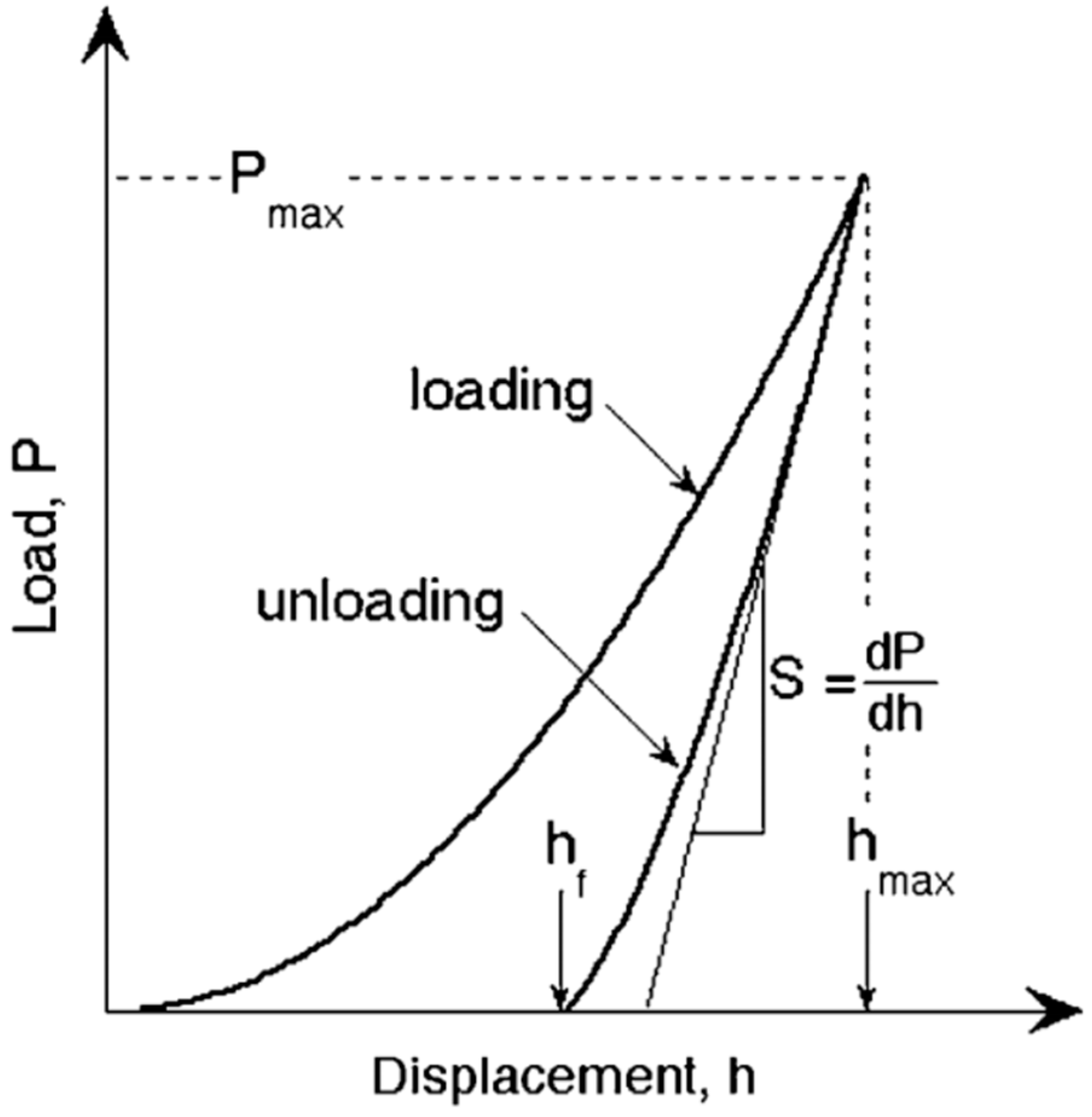

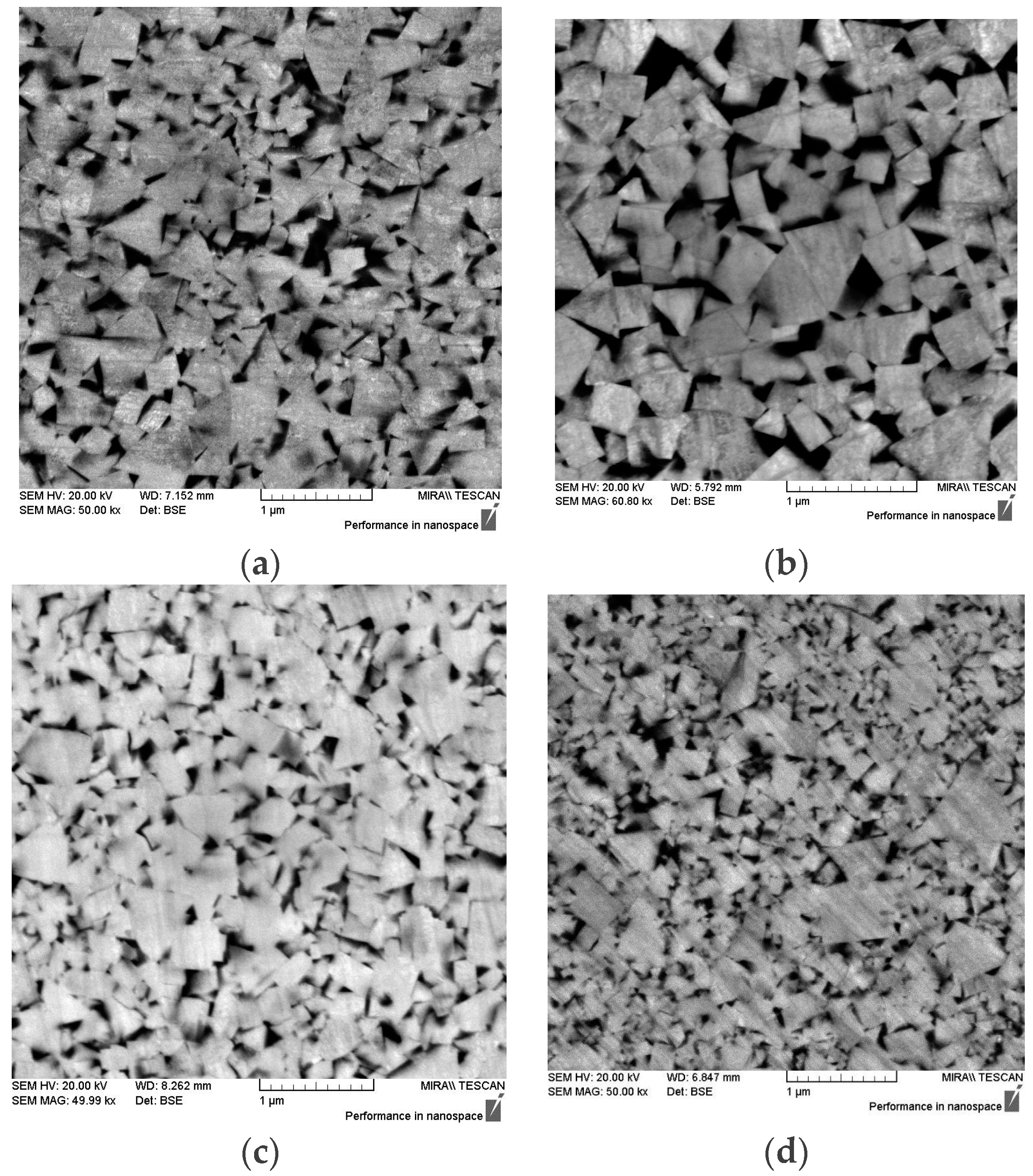
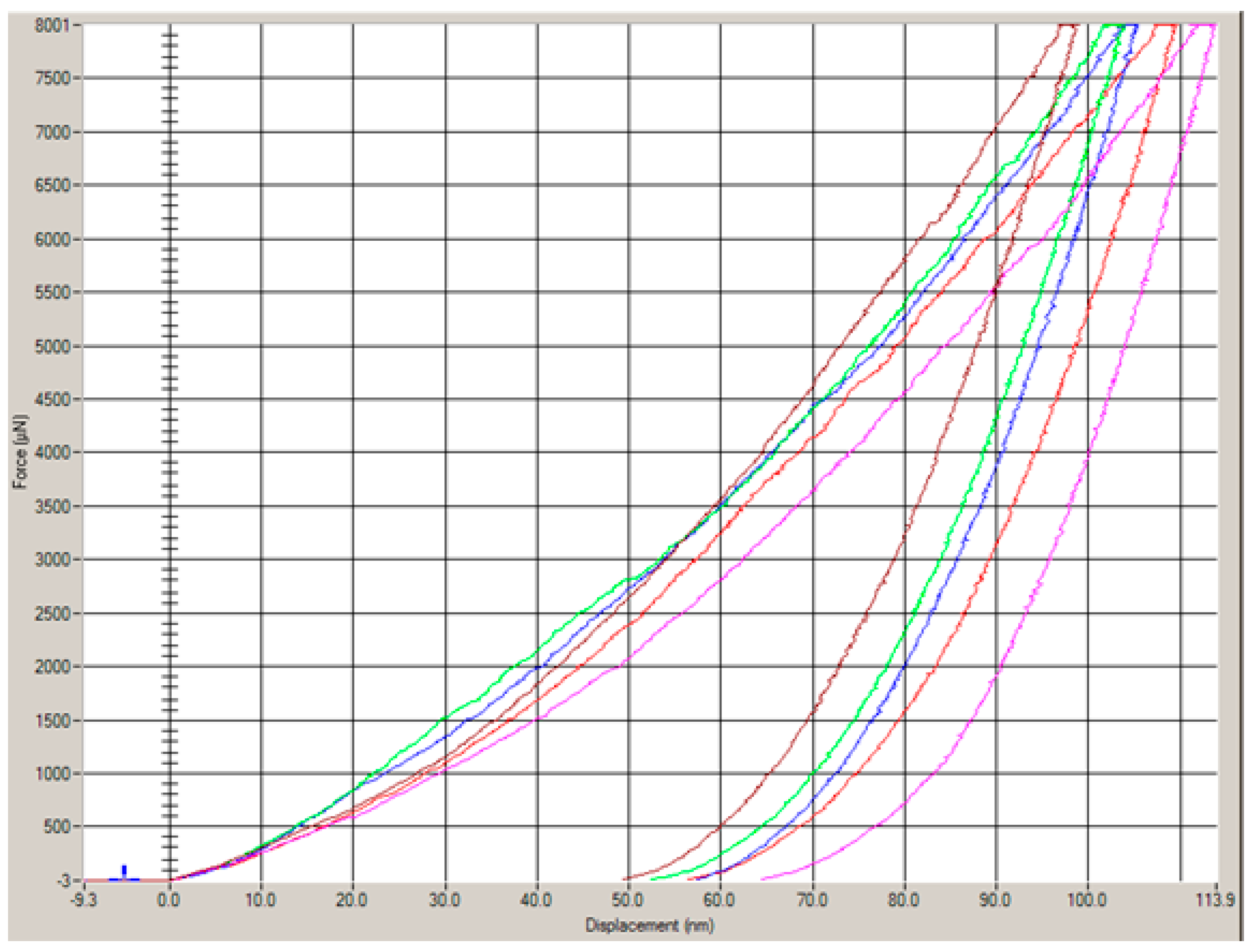
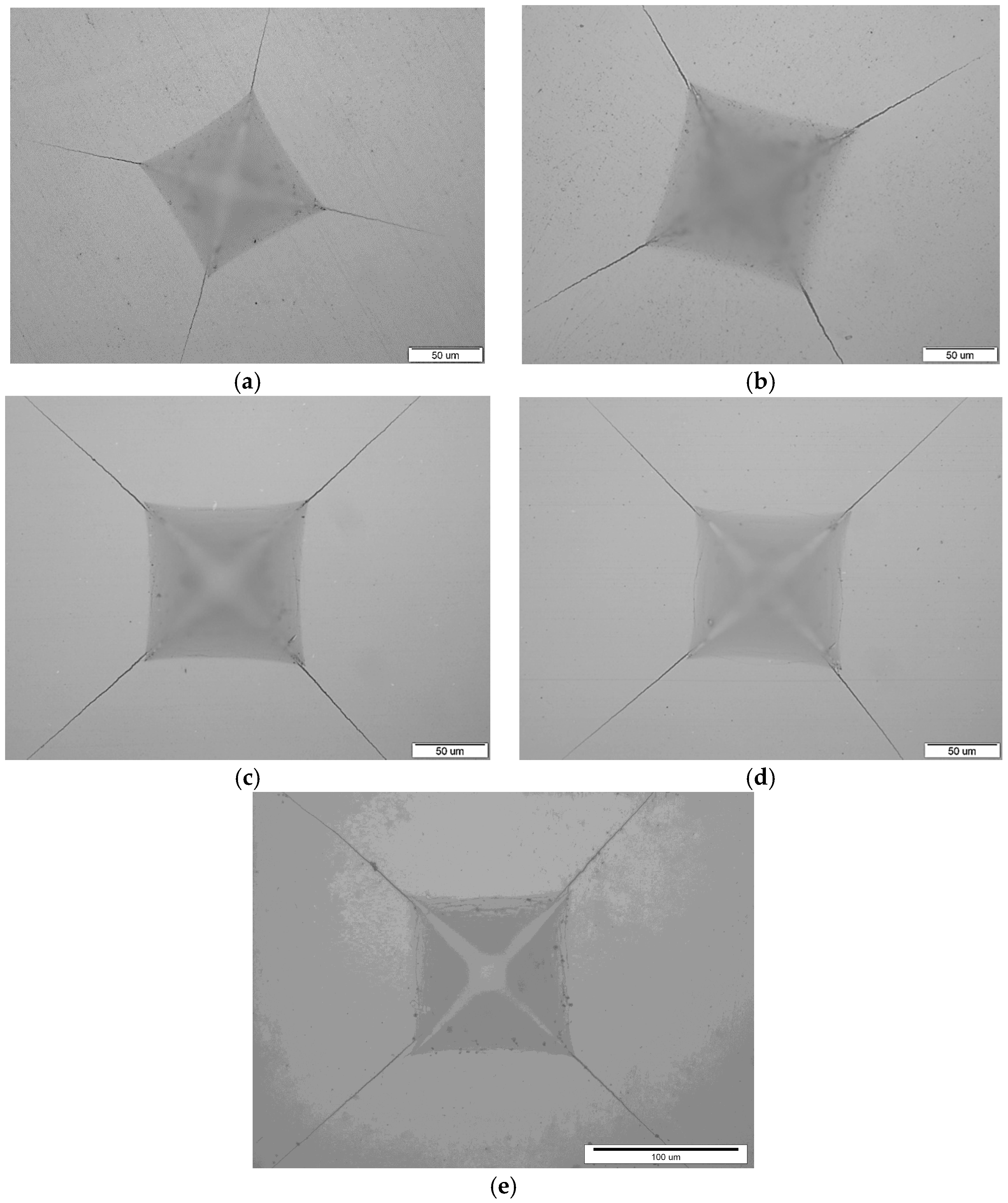
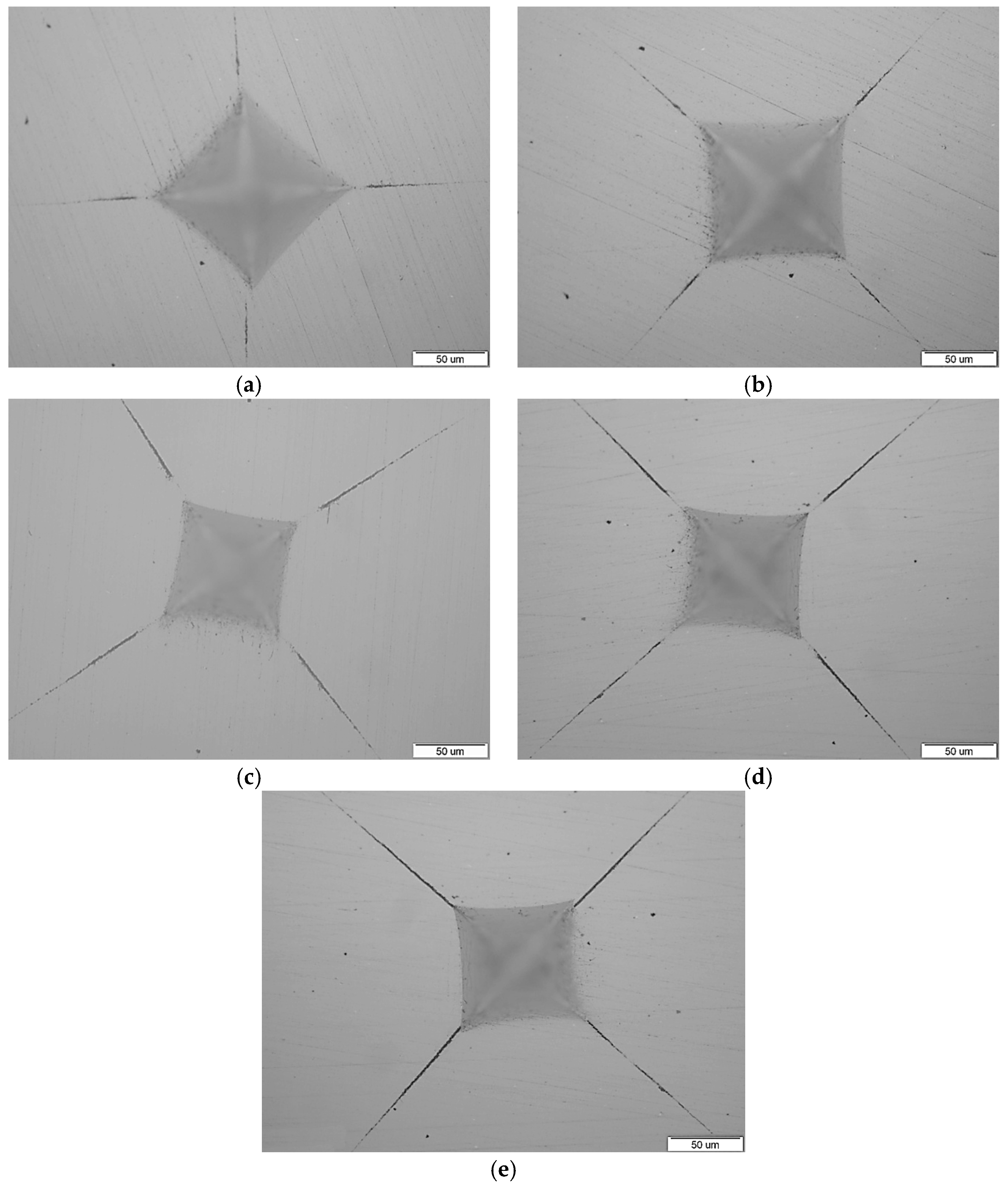
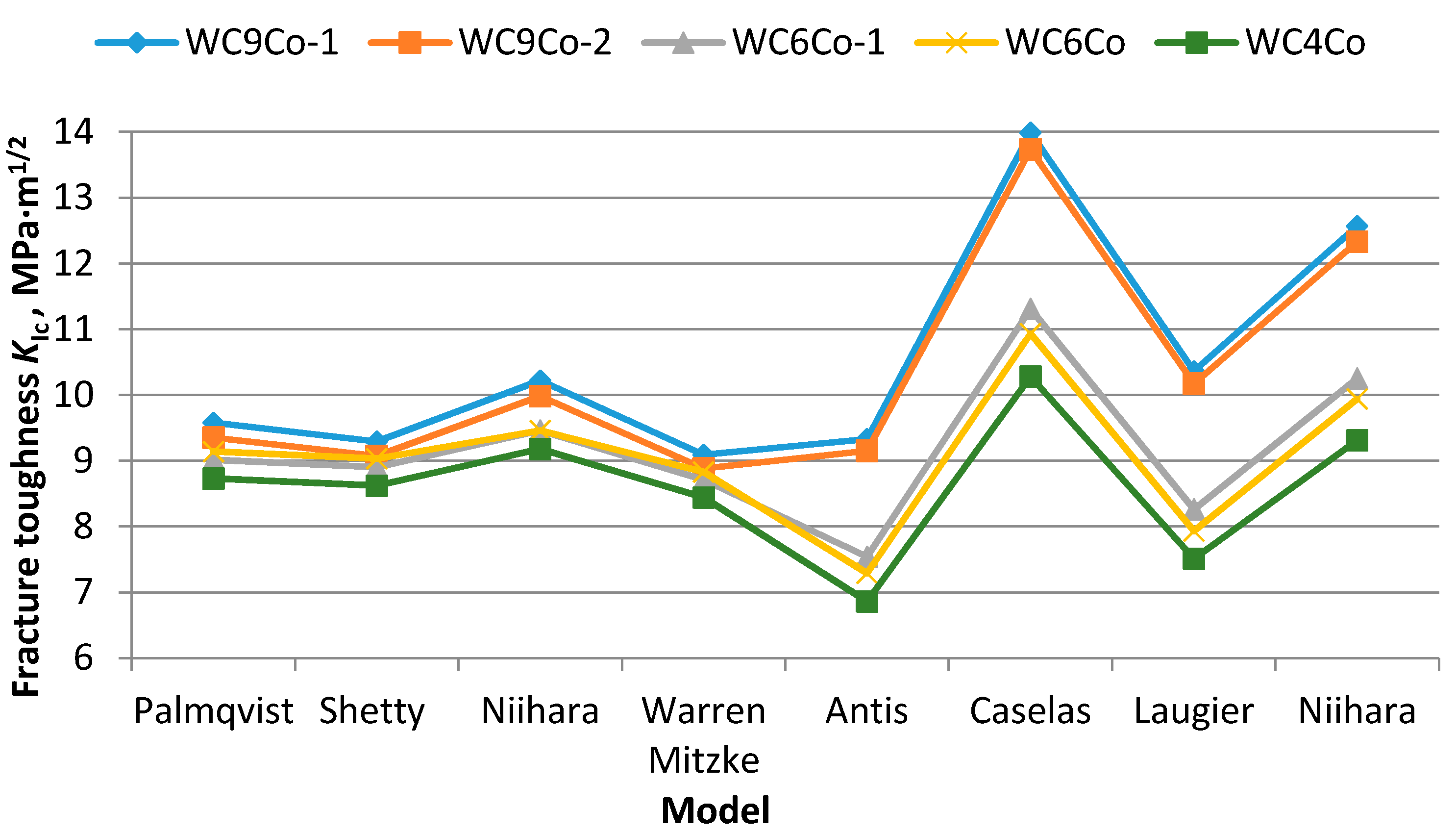
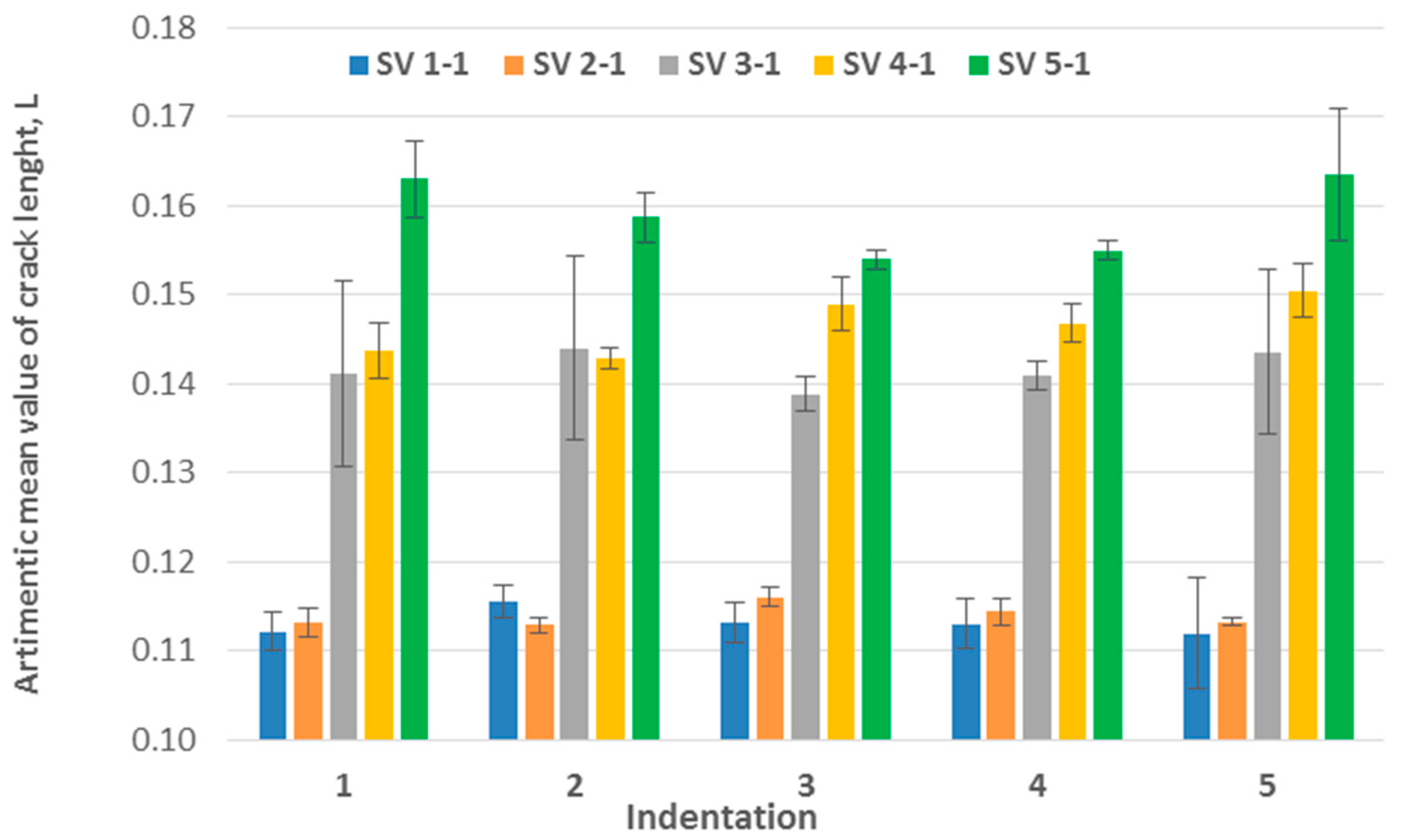
| Mixture | Powder | Grain Size dBET, nm | Specific Surface, m2/g | GGI, wt. % | Co, wt. % |
|---|---|---|---|---|---|
| WC9Co-1 | WC DN 2-5/1 | 150 | 2.57 | 0.26% VC, 0.45% Cr3C2 | 9 |
| WC9Co-2 | WC DN 2-5/2 | 150 | 2.59 | 0.27% VC | 9 |
| WC6Co-1 | WC DN 2-5/1 | 150 | 2.57 | 0.26% VC, 0.45% Cr3C2 | 6 |
| WC6Co | WC DN 4-0 | 95 | 3.92 | 0.41%VC, 0.80% Cr3C2 | 6 |
| WC4Co | WC DN 2-5/1 | 150 | 2.57 | 0.26% VC, 0.45% Cr3C2 | 4 |
| Mixture | Sample | HV 30 | Pc, N | W, N/mm | Er, GPa | νs | νi = νD | Ei = ED GPa | Es GPa |
|---|---|---|---|---|---|---|---|---|---|
| WC9Co-1 | SV 1-1 | 1879.3 | 19.614 | 606.8 | 358.6 | 0.227 | 0.075 | 890 | 566.7 |
| WC9Co-2 | SV 2-1 | 1809.4 | 19.614 | 602.6 | 350.0 | 0.227 | 544.4 | ||
| WC6Co-1 | SV 3-1 | 2041.1 | 9.807 | 502.1 | 362.7 | 0.222 | 577.6 | ||
| WC6Co | SV 4-1 | 2196.1 | 9.807 | 485.5 | 368.1 | 0.222 | 592.2 | ||
| WC4Co | SV 5-1 | 2140.1 | 9.807 | 448.1 | 374.5 | 0.220 | 609.9 |
| Mixture | Sample | Palmqvist Toughness, WK, MPa·m1/2 | Palmqvist Crack Model KIc, MPa·m1/2 | Radial-Median Crack Model KIc, MPa·m1/2 | |||||
|---|---|---|---|---|---|---|---|---|---|
| Shetty | Niihara | Warren Mitzke | Laugier | Antis | Caselas | Niihara | |||
| WC9Co-1 | SV 1-1 | 9.58 | 9.29 | 10.22 | 9.09 | 10.36 | 9.33 | 13.99 | 12.57 |
| WC9Co-2 | SV 2-1 | 9.35 | 9.07 | 9.98 | 8.88 | 10.17 | 9.15 | 13.73 | 12.33 |
| WC6Co-1 | SV 3-1 | 9.01 | 8.90 | 9.46 | 8.71 | 8.26 | 7.54 | 11.31 | 10.25 |
| WC6Co | SV 4-1 | 9.14 | 9.03 | 9.46 | 8.83 | 7.93 | 7.29 | 10.93 | 9.94 |
| WC4Co | SV 5-1 | 8.73 | 8.62 | 9.18 | 8.44 | 7.51 | 6.86 | 10.28 | 9.31 |
© 2017 by the authors. Licensee MDPI, Basel, Switzerland. This article is an open access article distributed under the terms and conditions of the Creative Commons Attribution (CC BY) license (http://creativecommons.org/licenses/by/4.0/).
Share and Cite
Aleksandrov Fabijanić, T.; Ćorić, D.; Šnajdar Musa, M.; Sakoman, M. Vickers Indentation Fracture Toughness of Near-Nano and Nanostructured WC-Co Cemented Carbides. Metals 2017, 7, 143. https://doi.org/10.3390/met7040143
Aleksandrov Fabijanić T, Ćorić D, Šnajdar Musa M, Sakoman M. Vickers Indentation Fracture Toughness of Near-Nano and Nanostructured WC-Co Cemented Carbides. Metals. 2017; 7(4):143. https://doi.org/10.3390/met7040143
Chicago/Turabian StyleAleksandrov Fabijanić, Tamara, Danko Ćorić, Mateja Šnajdar Musa, and Matija Sakoman. 2017. "Vickers Indentation Fracture Toughness of Near-Nano and Nanostructured WC-Co Cemented Carbides" Metals 7, no. 4: 143. https://doi.org/10.3390/met7040143







